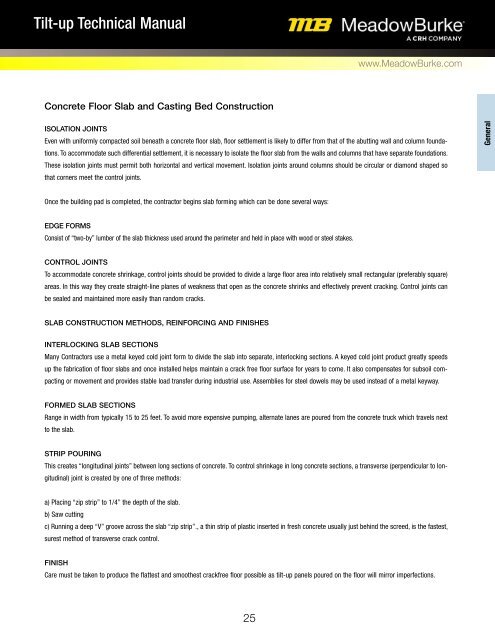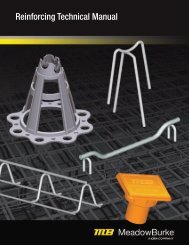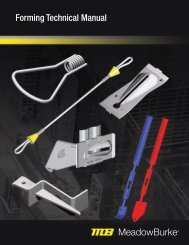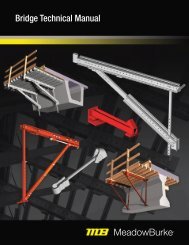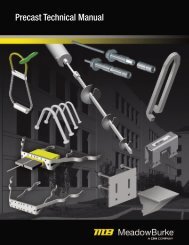Create successful ePaper yourself
Turn your PDF publications into a flip-book with our unique Google optimized e-Paper software.
<strong>Tilt</strong>-up <strong>Technical</strong> <strong>Manual</strong><br />
www.MeadowBurke.com<br />
Concrete Floor Slab and Casting Bed Construction<br />
ISOLATION JOINTS<br />
Even with uniformly compacted soil beneath a concrete floor slab, floor settlement is likely to differ from that of the abutting wall and column foundations.<br />
To accommodate such differential settlement, it is necessary to isolate the floor slab from the walls and columns that have separate foundations.<br />
These isolation joints must permit both horizontal and vertical movement. Isolation joints around columns should be circular or diamond shaped so<br />
that corners meet the control joints.<br />
General<br />
Once the building pad is completed, the contractor begins slab forming which can be done several ways:<br />
EDGE FORMS<br />
Consist of “two-by” lumber of the slab thickness used around the perimeter and held in place with wood or steel stakes.<br />
CONTROL JOINTS<br />
To accommodate concrete shrinkage, control joints should be provided to divide a large floor area into relatively small rectangular (preferably square)<br />
areas. In this way they create straight-line planes of weakness that open as the concrete shrinks and effectively prevent cracking. Control joints can<br />
be sealed and maintained more easily than random cracks.<br />
SLAB CONSTRUCTION METHODS, REINFORCING AND FINISHES<br />
INTERLOCKING SLAB SECTIONS<br />
Many Contractors use a metal keyed cold joint form to divide the slab into separate, interlocking sections. A keyed cold joint product greatly speeds<br />
up the fabrication of floor slabs and once installed helps maintain a crack free floor surface for years to come. It also compensates for subsoil compacting<br />
or movement and provides stable load transfer during industrial use. Assemblies for steel dowels may be used instead of a metal keyway.<br />
FORMED SLAB SECTIONS<br />
Range in width from typically 15 to 25 feet. To avoid more expensive pumping, alternate lanes are poured from the concrete truck which travels next<br />
to the slab.<br />
STRIP POURING<br />
This creates “longitudinal joints” between long sections of concrete. To control shrinkage in long concrete sections, a transverse (perpendicular to longitudinal)<br />
joint is created by one of three methods:<br />
a) Placing “zip strip” to 1/4” the depth of the slab.<br />
b) Saw cutting<br />
c) Running a deep “V” groove across the slab “zip strip”., a thin strip of plastic inserted in fresh concrete usually just behind the screed, is the fastest,<br />
surest method of transverse crack control.<br />
FINISH<br />
Care must be taken to produce the flattest and smoothest crackfree floor possible as tilt-up panels poured on the floor will mirror imperfections.<br />
25


